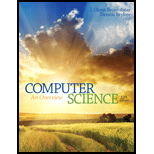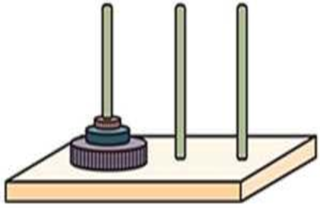
The puzzle called the Towers of Hanoi consists of three pegs, one of which contains several rings stacked in order of descending diameter from bottom to top. The problem is to move the stack of rings to another peg. You are allowed to move only one ring at a time, and at no time is a ring to be placed on top of a smaller one. Observe that if the puzzle involved only one ring, it would be extremely easy. Moreover, when faced with the problem of moving several rings, if you could move all but the largest ring to another peg, the largest ring could then be placed on the third peg, and then the problem would be to move the remaining rings on top of it. Using this observation, develop a recursive

Want to see the full answer?
Check out a sample textbook solution
Chapter 5 Solutions
Computer Science: An Overview (12th Edition)
Additional Engineering Textbook Solutions
Starting Out with Python (3rd Edition)
Starting out with Visual C# (4th Edition)
Introduction To Programming Using Visual Basic (11th Edition)
Starting Out with Java: From Control Structures through Objects (7th Edition) (What's New in Computer Science)
Artificial Intelligence: A Modern Approach
Problem Solving with C++ (10th Edition)
- Computer Science Given a dataframe with two columns (x and y), I have found a function on Python that gives a local fit value (essentially between two set values x it gives the average of all values of y). Now the questions asks us to create 2 graphs - one that shows the average per value of x and another one that shows the difference to that average that we found. What does this mean?arrow_forwardA robot starts on a point marked “A” on a rectangular grid of points. The starting point is always the top left point on the grid. The robot can move left, right, up or down, moving from one point to the next. By moving in steps going left, right, up or down, the robot would like to reach a point marked “B”, which is always the bottom right point in the grid. Sometimes, points are marked as “x”, and the robot is not allowed to visit them at all. A robot is never allowed to visit a point more than once. In how many ways can the robot move from A to B and visit all points along the way? For example, in the following grid, represented in text as A . . . . B there is only one path from A to B: In the following grid, represented in text as A . . x x B there is still only one path (we're lucky because of the two x's): However, in the grid A . . . x B there are no ways for the robot to move from A to B and visit all points that are not marked with “x”. Write a single…arrow_forwardA grid needs a system for numbering the tiles in order to allow random-access lookup.For instance, the rows and columns of a square grid provide a natural numbering for the tiles. Create plans for hexagonal and triangular grids. Create a rule for identifying the neighbourhood (i.e., nearby tiles) of a certain tile in the grid using the numbering scheme. For instance, the neighbourhood of tile I j in a four-connected square grid with indices of I for rows and j for columns may be described as neighbourhood(i, j) = I 1, j, I j 1.arrow_forward
- The Tower of Hanoi is a puzzle where n disks of different sizes arestacked in ascending order on one rod and there are two other rods with nodisks on them. The objective is to move all disks from the first rod to thethird, such that:- only one disk is moved at a time- a larger disk can never be placed on top of a smaller oneWrite a recursive function that outputs the sequence of steps needed tosolve the puzzle with n disks.Write a test program in C++ that allows the user to input number of disks andthen uses your function to output the steps needed to solve the puzzle.Hint: If you could move up n−1 of the disks from the first post to thethird post using the second post as a spare, the last disk could be moved fromthe first post to the second post. Then by using the same technique you canmove the n−1 disks from the third post to the second post, using the firstdisk as a spare. There! You have the puzzle solved. You only have to decidewhat the nonrecursive case is, what the recursive…arrow_forwardWrite a C PROGRAM for this problem: The partially initialized array "table" can be viewed as a primitive spreadsheet, in which the last column and bottom row have been left blank. Write the code to fill in this row and column with the totals of each column, each row, and the grand total.arrow_forward. The classical Tower of Hanoi (ToH) puzzle is well-known. It consists of three pegs and disks of sizes 1,2, . . . , n arranged on one of the pegs as a “tower”, in decreasing order of size, from bottom to top. The goal of the puzzle is to transfer all disks to another peg, placed in the same order. At each step, a single disk is moved from (the top of) one peg to (the top of) another, subject to the “divine” rule: to never have a larger disk above a smaller one.arrow_forward
- The classical Tower of Hanoi (ToH) puzzle is well-known. It consists of three pegs and disks of sizes 1,2, . . . , n arranged on one of the pegs as a “tower”, in decreasing order of size, from bottom to top. The goal of the puzzle is to transfer all disks to another peg, placed in the same order. At each step, a single disk is moved from (the top of) one peg to (the top of) another, subject to the “divine” rule: to never have a larger disk above a smaller one.Write an algorithm and draw the flow chart for moving all the disks from Peg A to Peg B.arrow_forwardCan you help me with this code because this is a little difficult for me:question that i need help with:The Lights Out puzzle consists of an m x n grid of lights, each of which has two states: on and off. The goal of the puzzle is to turn all the lights off, with the caveat that whenever a light is toggled, its neighbors above, below, to the left, and to the right will be toggled as well. If a light along the edge of the board is toggled, then fewer than four other lights will be affected, as the missing neighbors will beignored. In this section, you will investigate the behavior of Lights Out puzzles of various sizes by implementing a LightsOutPuzzle class task: A natural representation for this puzzle is a two-dimensional list of Boolean values, where True corresponds to the on state and False corresponds to the off state. In the LightsOutPuzzle class, write an initialization method __init__(self, board) that stores an input board of this form for future use. Also write a method…arrow_forwardIt is possible to represent human concepts (such as mathematics) in a programming language, so that we can get machines to obey specific rules. Because of this, a parser must convert OUR text and symbols into tokens. How come the machine doesn't simply do what we tell it to?arrow_forward
- Blackout Math is a math puzzle in which you are given an incorrect arithmetic equation. The goal of the puzzle is to remove two of the digits and/or operators in the equation so that the resulting equation is correct. For example, given the equation 6 - 5 = 15 ^ 4/2 we can remove the digit 5 and the / operator from the right-hand side in order to obtain the correct equality 6 - 5 = 1 ^ 42. Both sides of the equation now equal to 1. Observe how removing an operator between two numbers (4 and 2) causes the digits of the numbers to be concatenated (42). Here is a more complicated example: 288 / 24 x 6 = 18 x 13 x 8 We can remove digits and operators from either side of the equals sign (either both from one side, or one on each side). In this case, we can remove the 2 from the number 24 on the left-hand side and the 1 from the number 13 on the right-hand side to obtain the correct equality 288 / 4 x 6 = 18 x 3 x 8 Both sides of the equation now equal to 432. Here is another puzzle for you…arrow_forwardThe language must be in python. Just do numbers 5-7 Neural Network Units Implement a single sigmoid neural network unit with weights of [-1.2, -1.1, 3.3, -2.1] Calculate the outputs for two training examples:Example 1: [0.9, 10.0, 3.1, 1]Example 2: [0.9, 2.1, 3.7, 1] Note that you don't have to explicitly include a threshold or bias since the examples include a last element of 1 which means that the last weight effectively operates as a threshold. Assuming that a sigmoid unit response >0.5 denotes a positive class and <0.5 is negative class, is example 1 positive or negative? is example 2 positive or negative? Create a single ReLU unit and provide the outputs for those examples. Calculate the derivative of the sigmoid with respect to net input for both examples Calculate the derivative of the ReLU with respect to net input for both examplesarrow_forwardCan you answer with using Python programming language without using input ? A 2D matrix can be represented as a list and a column count value in Python. For example, the 3x3 matrix 1 2 3 4 5 6 7 8 9 can be row-wise represented as ([1,2,3,4,5,6,7,8,9], 3), where the number 3 represents the number of columns in the matrix. Similarly, 1 3 5 2 4 6 becomes ([1,3,5,2,4,6], 3). A submatrix can be defined as an (l,r,t,b) tuple, where l and r are left and right column indices, and t and b are top and bottom row indices (all inclusive). Write a function that takes a tuple containing the list representing a matrix, and the column count of the matrix, along with another tuple representing a specific submatrix, and returns the list representation of the submatrix along with its column count as a tuple. For example, given submatrix(([1,2,3,4,5,6,7,8,9,10,11,12], 4), (1,2,0,1)) returns: ([2,3,6,7], 2) because, ([1,2,3,4,5,6,7,8,9,10,11,12], 4) represents: 1 2 3 4 5 6 7 8 9 10 11 12 and (1,2,0,1)…arrow_forward
 Database System ConceptsComputer ScienceISBN:9780078022159Author:Abraham Silberschatz Professor, Henry F. Korth, S. SudarshanPublisher:McGraw-Hill Education
Database System ConceptsComputer ScienceISBN:9780078022159Author:Abraham Silberschatz Professor, Henry F. Korth, S. SudarshanPublisher:McGraw-Hill Education Starting Out with Python (4th Edition)Computer ScienceISBN:9780134444321Author:Tony GaddisPublisher:PEARSON
Starting Out with Python (4th Edition)Computer ScienceISBN:9780134444321Author:Tony GaddisPublisher:PEARSON Digital Fundamentals (11th Edition)Computer ScienceISBN:9780132737968Author:Thomas L. FloydPublisher:PEARSON
Digital Fundamentals (11th Edition)Computer ScienceISBN:9780132737968Author:Thomas L. FloydPublisher:PEARSON C How to Program (8th Edition)Computer ScienceISBN:9780133976892Author:Paul J. Deitel, Harvey DeitelPublisher:PEARSON
C How to Program (8th Edition)Computer ScienceISBN:9780133976892Author:Paul J. Deitel, Harvey DeitelPublisher:PEARSON Database Systems: Design, Implementation, & Manag...Computer ScienceISBN:9781337627900Author:Carlos Coronel, Steven MorrisPublisher:Cengage Learning
Database Systems: Design, Implementation, & Manag...Computer ScienceISBN:9781337627900Author:Carlos Coronel, Steven MorrisPublisher:Cengage Learning Programmable Logic ControllersComputer ScienceISBN:9780073373843Author:Frank D. PetruzellaPublisher:McGraw-Hill Education
Programmable Logic ControllersComputer ScienceISBN:9780073373843Author:Frank D. PetruzellaPublisher:McGraw-Hill Education





